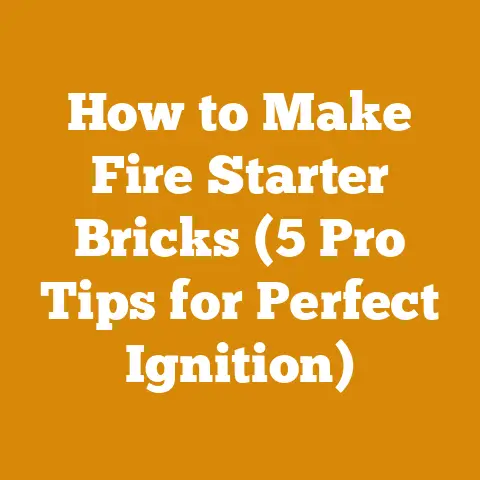How to Install Fire Bricks in Wood Stove (5 Pro Tips for Durability)
Did you know that a single improperly installed fire brick can reduce your wood stove’s efficiency by up to 25%?
That’s a shocking waste of heat and firewood!
I’ve spent years tinkering with wood stoves, and I’ve learned firsthand how crucial proper fire brick installation is.
It’s not just about slapping them in; it’s about precision, the right materials, and understanding the science behind heat retention.
In this guide, I’ll share my hard-earned knowledge and give you five pro tips to ensure your fire bricks last longer and your wood stove burns hotter and more efficiently.
Let’s dive in and make sure you’re not losing valuable heat up the chimney!
How to Install Fire Bricks in Wood Stove (5 Pro Tips for Durability)
Understanding the Importance of Fire Bricks
Fire bricks aren’t just there to look pretty in your wood stove.
They’re the unsung heroes of efficient heating.
They protect the stove’s metal from the intense heat of the fire, preventing warping and cracking.
More importantly, they act as a thermal mass, absorbing heat during the fire and radiating it back into the room long after the flames have died down.
Think of them like a battery for heat.
A good set of fire bricks can significantly extend the heating cycle and reduce the amount of wood you need to burn.
I’ve seen firsthand how a well-maintained stove with properly installed bricks can keep a room warm for hours longer than one without.
Preparing for the Installation
Before you even think about touching a fire brick, preparation is key.
This isn’t a race; it’s a marathon.
Taking the time to do it right upfront will save you headaches (and money) down the road.
Gathering Your Tools and Materials
You’ll need a few essential tools and materials for this project:
- New Fire Bricks: Obviously!
Make sure you get the right size and quantity for your stove model.
Check your owner’s manual or measure the old bricks if you’re replacing them. - Fire Cement (Refractory Mortar): This high-temperature mortar is crucial for sealing the bricks and preventing air leaks.
Don’t skimp on quality here. - Trowel or Putty Knife: For applying the fire cement.
- Rubber Mallet: For gently tapping the bricks into place.
A metal hammer is a big no-no. - Measuring Tape: To ensure accurate placement.
- Wire Brush: For cleaning the stove interior.
- Safety Glasses and Gloves: Always prioritize safety!
- Shop Vacuum: For cleaning up debris.
Inspecting the Stove Interior
Before you start, give your wood stove a thorough inspection.
Look for any signs of damage, like cracks or rust.
Address any issues before installing the new bricks.
Clean the interior of the stove with a wire brush and shop vacuum to remove any ash, soot, or debris.
A clean surface will help the fire cement adhere properly.
I once skipped this step and paid the price.
I installed new bricks over a layer of soot, and they started to loosen within a few months.
Understanding Your Stove’s Brick Configuration
Each wood stove model has a specific brick configuration.
Consult your owner’s manual or take photos of the old brick arrangement before removing them.
This will save you a lot of guesswork later.
Pay attention to the orientation of the bricks and any specific patterns.
Some stoves have angled bricks or bricks that fit together in a particular way.
Pro Tip #1: Choosing the Right Fire Bricks
Not all fire bricks are created equal.
There are different grades and types, each with its own properties and applications.
Understanding Fire Brick Grades
Fire bricks are typically graded based on their alumina content and their ability to withstand high temperatures.
Higher alumina content generally means better heat resistance and durability.
- Standard Fire Bricks: These are the most common and affordable type.
They’re suitable for most wood stoves and can withstand temperatures up to around 2,000°F (1,093°C). - High-Duty Fire Bricks: These bricks have a higher alumina content and can withstand temperatures up to around 2,500°F (1,371°C).
They’re a good choice for stoves that are used frequently or that burn very hot. - Super-Duty Fire Bricks: These are the highest grade of fire bricks and can withstand temperatures up to around 3,000°F (1,649°C).
They’re typically used in industrial applications, but they can be used in high-end wood stoves for maximum durability.
Sizing and Cutting Fire Bricks
Getting the right size fire brick is critical.
Most manufacturers sell standard sizes that fit common wood stove models.
However, you may need to cut some bricks to fit specific areas.
- Measuring: Measure the area where the brick will be installed carefully.
Use a measuring tape and record the dimensions accurately. - Cutting: I recommend using a wet tile saw with a diamond blade.
This will give you a clean, precise cut and minimize dust.
If you don’t have a wet tile saw, you can use a masonry saw or a chisel and hammer, but be prepared for a lot of dust and a less precise cut. - Safety: Always wear safety glasses and a dust mask when cutting fire bricks.
Takeaway: Choose the right grade of fire brick for your stove and cut them precisely to ensure a snug fit.
This will maximize heat retention and prevent premature failure.
Pro Tip #2: Mastering the Art of Fire Cement Application
Fire cement is the glue that holds everything together.
Applying it correctly is crucial for creating a tight seal and preventing air leaks.
Preparing the Fire Cement
Follow the manufacturer’s instructions for mixing the fire cement.
Most fire cements come as a dry powder that needs to be mixed with water.
Add water gradually until you achieve a thick, paste-like consistency.
Avoid adding too much water, as this will weaken the cement.
I’ve found that letting the mixed cement sit for about 10-15 minutes before applying it helps to improve its workability.
Applying the Cement
Use a trowel or putty knife to apply a generous layer of fire cement to the back and sides of each brick.
Make sure to cover the entire surface that will be in contact with the stove walls or other bricks.
Press the brick firmly into place and wiggle it slightly to ensure good contact with the cement.
Use a rubber mallet to gently tap the brick into its final position.
Remove any excess cement with your trowel or putty knife.
You want a smooth, clean joint between the bricks.
Curing the Cement
Most fire cements require a curing period before you can use the stove.
Follow the manufacturer’s instructions for curing.
This typically involves allowing the cement to air dry for 24-48 hours before lighting a small fire in the stove.
Gradually increase the size of the fire over several days to allow the cement to fully cure.
I made the mistake of firing up my stove too quickly after installing new bricks once, and the cement cracked.
Patience is key!
Takeaway: Mix the fire cement properly, apply it generously, and allow it to cure completely before using your stove.
This will create a strong, airtight seal that will last for years.
Pro Tip #3: Achieving a Snug and Secure Fit
A loose or poorly fitted fire brick is a recipe for disaster.
It will allow heat to escape, reduce the stove’s efficiency, and potentially damage the stove itself.
Ensuring Proper Alignment
Pay close attention to the alignment of the bricks.
They should be flush with each other and with the stove walls.
Use a measuring tape and a level to ensure that everything is straight and even.
If you’re installing bricks on the floor of the stove, make sure they’re level.
An uneven floor can cause the bricks to crack or shift over time.
Filling Gaps and Cracks
Even with precise cutting and careful installation, you may still end up with small gaps or cracks between the bricks.
Fill these gaps with fire cement to prevent air leaks.
Use a small trowel or putty knife to force the cement into the gaps.
Smooth the surface of the cement to create a seamless joint.
For larger gaps, you may need to use a backer rod or other filler material to support the cement.
Using Shims (If Necessary)
In some cases, you may need to use shims to achieve a snug fit.
Shims are thin pieces of metal or ceramic that can be inserted behind the bricks to fill gaps or adjust their position.
I’ve used shims made from scraps of fire brick to fine-tune the fit of bricks in odd-shaped stoves.
Takeaway: Strive for a snug and secure fit.
Use shims and fire cement to fill any gaps or cracks and ensure that the bricks are properly aligned.
Pro Tip #4: Protecting the Bricks from Mechanical Damage
Fire bricks are designed to withstand high temperatures, but they’re surprisingly vulnerable to mechanical damage.
Dropping a log on a fire brick can easily crack or break it.
Gentle Loading of Wood
Avoid throwing logs into the stove.
Gently place them inside to minimize the risk of impact damage.
I always tell people to treat their fire bricks like they’re handling eggs.
Be careful and avoid any sudden impacts.
Using a Fireplace Grate
A fireplace grate can help to protect the fire bricks from direct contact with the logs.
The grate elevates the logs, allowing air to circulate underneath and preventing them from sitting directly on the bricks.
Choose a grate that is the right size for your stove and that is made from durable materials.
Regular Inspection and Maintenance
Inspect your fire bricks regularly for any signs of damage, like cracks or chips.
Replace any damaged bricks immediately to prevent further damage to the stove.
I recommend inspecting the bricks at least once a year, preferably before the start of the heating season.
Takeaway: Protect your fire bricks from mechanical damage by loading wood gently, using a fireplace grate, and performing regular inspections.
Pro Tip #5: Optimizing Airflow for Efficient Burning
Proper airflow is essential for efficient combustion and heat transfer.
The way you arrange your fire bricks can have a significant impact on airflow.
Ensuring Adequate Airflow Channels
Make sure that the fire bricks don’t block any of the stove’s air inlets or outlets.
These channels are designed to provide oxygen to the fire and to allow the exhaust gases to escape.
If the bricks are blocking the airflow, the fire will smolder and produce more smoke.
This will reduce the stove’s efficiency and increase the risk of creosote buildup in the chimney.
Creating a Convection Chamber
Some stoves are designed with a convection chamber, which is a space behind the fire bricks that allows air to circulate and absorb heat.
Make sure that the fire bricks don’t block this chamber.
A properly designed convection chamber can significantly increase the stove’s heat output.
Experimenting with Brick Placement
You can experiment with different brick placements to optimize airflow and heat transfer.
For example, you could try angling the bricks to direct airflow towards the back of the stove.
I’ve found that slightly raising the bricks on the floor of the stove can improve airflow and combustion.
Takeaway: Optimize airflow by ensuring that the fire bricks don’t block any air inlets or outlets, by maintaining a convection chamber, and by experimenting with different brick placements.
Troubleshooting Common Problems
Even with the best preparation and installation, you may still encounter some problems with your fire bricks.
Here are some common issues and how to address them:
- Cracking: Cracking is a common problem, especially with standard fire bricks.
It’s usually caused by thermal stress or mechanical damage.
Replace any cracked bricks immediately. - Spalling: Spalling is when the surface of the brick starts to flake or crumble.
It’s usually caused by moisture or chemical attack.
Use high-quality fire bricks and avoid burning wet or treated wood to prevent spalling. - Loosening: If the bricks start to loosen, it’s usually a sign that the fire cement has failed.
Reapply fire cement to secure the bricks. - Excessive Soot Buildup: Excessive soot buildup can be a sign of poor combustion.
Make sure the bricks aren’t blocking airflow and that you’re burning dry, seasoned wood.
The Long-Term Benefits of Proper Installation
Investing the time and effort to install your fire bricks correctly pays off in the long run.
A well-maintained wood stove with properly installed bricks will:
- Burn More Efficiently: You’ll use less wood to heat your home.
- Last Longer: The stove will be protected from the intense heat of the fire.
- Produce Less Smoke: Efficient combustion reduces smoke and creosote buildup.
- Provide More Consistent Heat: The thermal mass of the bricks will help to regulate the temperature in your home.
Maintaining Your Fire Bricks
Once your fire bricks are installed, you’ll want to keep them in good shape to maximize the lifespan of your stove and maintain its efficiency.
Regular Cleaning
Regular cleaning can prevent the buildup of soot and ash, which can degrade the fire bricks over time.
Use a soft brush or a shop vacuum to remove loose debris from the bricks.
Avoid using harsh chemicals or abrasive cleaners, as these can damage the surface of the bricks.
Careful Wood Selection
The type of wood you burn can also affect the lifespan of your fire bricks.
Burning wet or unseasoned wood can create excessive moisture and creosote, which can damage the bricks.
Always burn dry, seasoned wood to ensure efficient combustion and minimize the risk of damage.
Annual Inspections
Perform an annual inspection of your fire bricks to check for any signs of wear or damage.
Look for cracks, chips, or spalling.
Replace any damaged bricks promptly to prevent further damage to your stove.
Wood Types and Their Impact on Fire Bricks
The type of wood you burn has a significant impact on the health and longevity of your fire bricks.
Some woods burn hotter and cleaner than others, and some produce more ash and creosote.
Hardwoods vs. Softwoods
Hardwoods, like oak, maple, and birch, are generally preferred for wood stoves because they burn hotter and longer than softwoods, like pine and fir.
Hardwoods also produce less smoke and creosote.
Softwoods, on the other hand, tend to burn quickly and produce more smoke and creosote.
They can also create more sparks, which can be a fire hazard.
While softwoods can be used for kindling or starting fires, they should not be used as the primary fuel source for your wood stove.
Seasoning Wood
Seasoning wood is the process of drying it out to reduce its moisture content.
Dry wood burns hotter and cleaner than wet wood, and it produces less smoke and creosote.
To season wood, stack it in a well-ventilated area and allow it to dry for at least six months, or preferably a year.
The ideal moisture content for firewood is between 15% and 20%.
You can use a moisture meter to check the moisture content of your wood.
Avoiding Treated Wood
Never burn treated wood in your wood stove.
Treated wood contains chemicals that can release toxic fumes when burned.
These fumes can be harmful to your health and can also damage your wood stove and chimney.
Safety Considerations
Working with fire bricks and wood stoves can be dangerous if you’re not careful.
Always follow these safety precautions:
- Wear safety glasses and gloves to protect your eyes and hands.
- Work in a well-ventilated area to avoid inhaling dust and fumes.
- Use caution when lifting heavy objects to avoid back injuries.
- Follow the manufacturer’s instructions for your wood stove and fire bricks.
- Have your chimney inspected and cleaned regularly to prevent creosote buildup.
Advanced Techniques for Fire Brick Installation
For those looking to take their fire brick installation skills to the next level, here are a few advanced techniques:
Custom Fire Brick Designs
Some wood stove enthusiasts create custom fire brick designs to optimize airflow and heat transfer.
This can involve cutting and shaping the bricks to create specific patterns or channels.
Using Ceramic Fiber Insulation
Ceramic fiber insulation can be used to insulate the back and sides of the fire bricks, further increasing the stove’s efficiency.
This insulation is lightweight and can withstand extremely high temperatures.
Applying a Protective Coating
A protective coating can be applied to the surface of the fire bricks to prevent spalling and other types of damage.
There are several commercially available coatings that are specifically designed for fire bricks.
Conclusion: A Hot Topic Done Right
Installing fire bricks in your wood stove isn’t just a chore; it’s an investment in the efficiency, longevity, and safety of your heating system.
By following these five pro tips and taking the time to do the job right, you can ensure that your fire bricks last longer, your wood stove burns hotter, and your home stays warmer all winter long.
So, grab your tools, roll up your sleeves, and get ready to transform your wood stove into a heat-generating powerhouse.
And remember, a little bit of effort upfront can save you a lot of headaches (and money) down the road.
Now go forth and conquer the world of fire brick installation!






